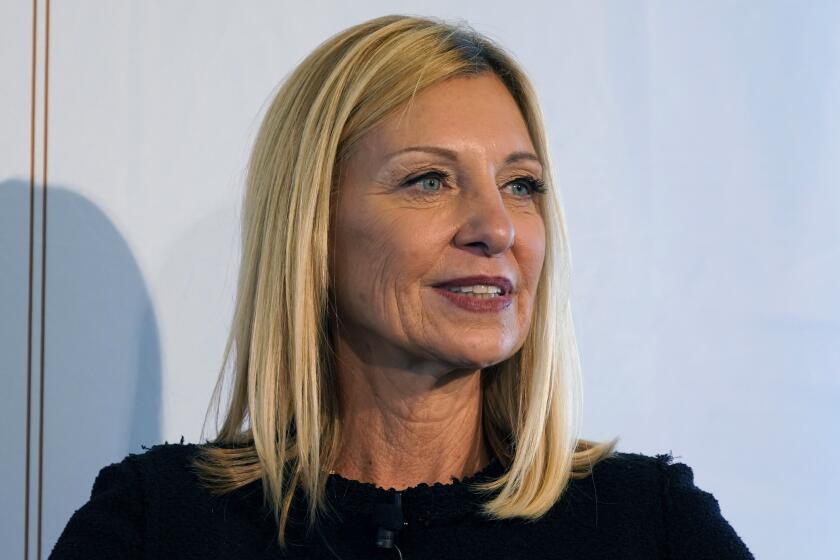50 Million Dimples : Riveter Whose Career Spans the Supersonic Era Is Calling It Quits
During the past 32 years Etta Goeser has punched more than 50 million dimples in the 3,806 T-38/F-5 series of supersonic planes produced by Northrop.
She has dimpled every one of the earlier 1,189 T-38 Talon trainers and every one of the 2,617 F-5 Tiger II fighters.
“When I started out dimpling the T-38s I had dimples. Now my dimples have turned into wrinkles,” laughed Goeser, who will retire on her 65th birthday March 31. She has been a Northrop employee since Sept. 20, 1950.
The 5-foot-4 Fullerton grandmother operates a dimpler machine, a device that compresses and hardens holes for rivets and other fasteners. She was the only dimpler assigned to the supersonic T-38s and F-5s since the work began on the prototype of the Talon trainer in 1957.
Widely Deployed
Now as the T-38 and F-5 program ends at Northrop’s Fighter Production Center in El Segundo, Goeser is also calling it quits.
T-38 Talons were the world’s first supersonic aircraft to be built as trainers. Thousands of U.S. Air Force pilots have trained in the jets. Jacqueline Cochran set six womens’ flight records in a T-38. Maj. Walter Daniel set four international time-to-climb records in the plane.
The F-5 Tiger II, which was developed from the T-38, is the most widely deployed U.S.-built supersonic aircraft in the non-Communist world. Thirty nations in addition to the United States, from the sheikdom of Bahrain to the island nation of Singapore, have the low-cost, reliable jet fighter in their Air Force inventories.
“I have helped hold all those buggers together with this machine,” said Goeser, as she gave her dimpler an affectionate pat. “None of my dimples have ever cracked, so far as I know.”
She sat in the last of the F-5s, the fighter purchased by Singapore, for a photograph. “This is the first time I have ever been in the cockpit of one of these planes in all these years. I love it. I always hoped I would fly in one, but no one ever invited me to go along,” she lamented.
At the height of the F-5 production in the 1960s, there were 5,600 employees building the aircraft, turning out as many as 18 a month. Sales of the T-38s and F-5s to the U.S. Air Force and overseas governments totaled more than $6 billion over 32 years. The first of the T-38s sold for less than $750,000 and the last of the F-5s for more than $9 million.
A ceremony was held at Wright-Patterson Air Force Base in Ohio in January, 1987, marking the end of the F-5 program. But five more of the jets have been sold since then to Singapore. “Honest to goodness this is the last of the fighters. The program is now finished,” insisted Terry L. Clawson, manager of public information for Northrop.
Master Mechanic
The 3,806th supersonic jet will be trucked from El Segundo to Mojave for final assembly with the last of the planes scheduled for delivery three months from now. Every one of the planes were delivered on schedule at or below contract price, according to Clawson.
Goeser has received many honors during her Northrop career, including being named one of the company’s 10 outstanding employees in 1975 on her 25th anniversary with the firm.
For the past 3 1/2 years, while production on the F-5s wound down, she has also worked as a master mechanic, supervising eight other workers assembling components for the F/A-18 Navy Hornet.
“When I was hired, Northrop had 7,600 employees. Now there are more than 45,000. I worked a swing shift in the beginning, and we would eat dinner watching a movie in an outdoor theater, a half-hour of the movie each night until it finished,” the super dimpler recalled.
“Jack Northrop, who founded the company, would drop by and if he liked the movie would sit with four of us girls, watching it every night all week until it was over.”
More to Read
Inside the business of entertainment
The Wide Shot brings you news, analysis and insights on everything from streaming wars to production — and what it all means for the future.
You may occasionally receive promotional content from the Los Angeles Times.










